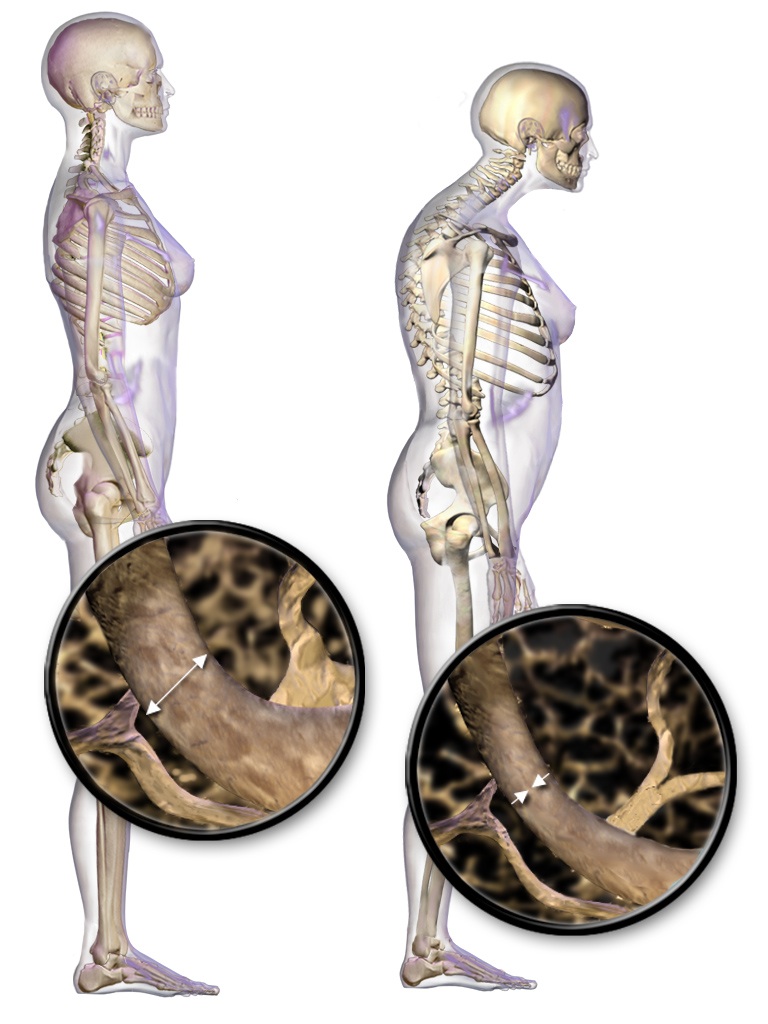Osteoporosis Prevention

Tid Bits of Info
- Osteoporosis can be prevented in many people if they take the proper preventive measures.
- Osteoporosis has no known cause and most times there are no symptoms.
- Your doctor might prescribe supplemental vitamins if your blood levels are too low.
- This can be assessed during your annual physical examination.
- Bone density exams are the best way to diagnose osteoporosis.
- Your Physical Therapist can help you with a well-designed exercise routine that will include cardiovascular and strength training activities.
It’s never too early to begin preventing osteoporosis. Making healthy lifestyle choices play a vital role in preventing or reducing the effects of osteoporosis. Normally, healthy human bones are extremely hard and dense, but some people age will suffer from a thinning of their bones as they age. Since there are no symptoms, they don’t realize the condition until they develop a painful fracture site.
Defining and Diagnosing Osteoporosis
Osteoporosis, porous bone, is a disease of the bones that occurs in 25-50% of all people over the age of 50. Women are more susceptible, but men can be affected just as easily without the proper precautions. When the bones lose density, they are more likely to fracture under too much stress. Unfortunately, the simple acts of daily living can cause too much stress, resulting in a fracture site that is painful and debilitating.
Bone is actually a tissue type. Healthy bones are constantly replenishing: new bone cells will replace cells that have died or are non-functional and the “old” ones are reabsorbed. This is a naturally occurring process that helps to maintain the density and strength of a bone. If the body does not manufacture “new” bone cells or the re-absorption process exceeds the production of new cells or both occur at the same time, the bone weakens as it becomes less dense, more porous and brittle.
Osteoporosis is diagnosed through a bone density study. Unfortunately osteoporosis does not have any significant “signs” in the early stages of its onset. In many cases, a person develops pain in their back, hand, hip or foot and an x-ray reveals a fracture site. Most of these fractures occur without any trauma to the area. These fractures can be especially painful in the spine and often are diagnosed as compression fractures. Literally the body of the vertebra “collapses” and can eventually cause someone to lose a significant amount of height and develop a familiar “hump” in the rib cage area.
Doctors and researchers are not 100% sure of the exact cause of osteoporosis, but they have narrowed down some of the primary causes to the disease. Diet, lack of exercise, some medicines, certain hormones, heredity and some lifestyle activities can be a cause to the development of osteoporosis. A series of life choices can play a vital role in reducing the likelihood of suffering from this condition.
Healthy Choices to Prevent Osteoporosis
Preventing osteoporosis is your best plan. Avoid smoking and drinking too much alcohol. Eat a proper, well-balanced diet that includes adequate levels of calcium and vitamin D. Consult your doctor to see if you will require a supplement. Exercise regularly including weight bearing activities and a full-body resistance program. Talk to your Physical Therapist about designing a well-rounded program that can help you accomplish your goals without causing joint damage.
Here are some specifics to keep in mind:
Diet: Calcium and vitamin D are critical factors in bone development. Calcium is one of the main components used to produce bone cells, and vitamin D helps the body absorb it into the bone tissue allowing the replenishment process to occur. Your doctor can perform a blood test to determine if your daily diet is enriching your body properly with enough of either or both. If needed, you’ll receive a prescription to supplement your daily intake of one or both. In general, 1000mg of calcium are needed prior to the age of 50, and this rises to 1200mg per day when someone is over the age 50. Vitamin D requirements are 600-800 IU(international units) per day in almost everyone.
Exercise: Weight bearing exercises have been shown to slow down the progression and help to prevent the onset of osteoporosis. The bones will respond to stresses and forces by producing more bone cells. This process will help the bone to produce an adequate amount of bone to counteract the effects of re-absorption.
Medicines and Hormones: Some medicines can make the bones more susceptible to re-absorption and hinder the development of new cells. Prolonged use of corticosteroids, commonly used for chronic inflammatory diseases or to prevent some types of seizures can cause the bones to become very brittle. Gender related hormones, Estrogen and Testosterone, can effect the production of new bone cells and causes the bones to weaken as the hormone levels drop. Women who are going through or have reached menopause are more susceptible the development of osteoporosis. Some treatments for cancer can cause a drop in these hormones.
You should discuss your situation with your doctor. Hormone replacement therapy has been used in to combat the effects of low estrogen in some women who are high-risk candidates for fractures due to the fragility of their bones. Unfortunately, this treatment has been linked to a higher incidence of breast cancer therefore you and your doctor have to decide if it is right for you. There are other drugs that help to strengthen bones if hormone replacement therapy is not a good option. Abnormal activity in the thyroid, parathyroid and the adrenal glands can lead to a similar condition of brittle bones.
Heredity and Lifestyle: Some people are more prone to osteoporosis development than others due to their family history. People of Caucasian and Asian descent are more prone to osteoporosis. Also, if they are small in stature and have a family member who had the disease they are much more susceptible to the disease. Alcoholism, eating disorders, GI surgery, smoking and a sedentary of lifestyle can all raise the risk of developing osteoporosis.
Osteoporosis is a disease that can be prevented in many people if they take the proper preventative measures to ensure that their bones are well nourished and are subjected to the proper amount of force that will facilitate the production of new cells. The prevention of this disease must begin early in one’s life. Waiting until there are symptoms is too late. Changes in the way one eats and acts are the best medicine when it comes to preventing osteoporosis.


























I know that this article states that weight bearing activities are beneficial to help combat or slow the progression of osteoporosis, but what about strength training or progressive resistance exercises? Would using heavier weights cause more stresses on the bone and therefore produce even more new bone cells?
Strength training and resistance exercises have been proven by research to be extremely beneficial for increasing bone mineral density. Using heavier weights to cause more stress on the bone will improve results, however there is a limit.
“The Effectiveness of Strength Training Program on Bone Mineral Density in Postmenopausal Women” by Dhillon et. al. is a great study that looked at the effects of strength training on bone mineral density in comparison to using just a calcium supplement, or not doing anything at all. The study divided its 30 subjects into 3 different groups. Ten women underwent an intensive 12 week strength training protocol that required 5 days/week of training for 1 hour each day. Ten women only took a calcium supplement prescribed by a physician, and the last group of 10 women did not receive treatment. The study found that the women who only took the supplement and the women who did not receive treatment did not see improvement in bone mineral density. The women who did not receive treatment actually had a decrease in bone mineral density due to lack of weight bearing. However, the strength training group had a significant increase in bone mineral density after 12 weeks.
So, strength training will improve the production of more new bone cells in comparison to weight bearing activities. However, where is the line between safe strength training and pushing the limits of using weights that may be too heavy for an individual? The previously mentioned study started participants out at a reasonable weight and slowly increased the amount of weights used every three weeks. The amount of weight was determined by each individual’s “one rep max”. A one rep max measures the maximum amount of weight that a given muscle can move through a complete contraction one time, with good form. The first three weeks, participants used a weight that was 50% of their one rep max. Weeks 3-6, participants used increased their weight to 60% of their one rep max. Finally, by weeks 9-12 weight was increased to 80% of their one rep max. To avoid injury while strength training, it is important to know your limits!